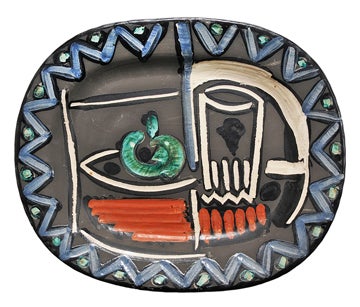ReStore volunteer discovers $7,000 Picasso platter
Published 10:52 pm Monday, January 27, 2014

Robert Stepp, volunteer, and D’Lee Worden, volunteer coordinator, were pleased to discover the Picasso plate donated to the ReStore. Here they look at another donation, delicately carved wood from Thailand that might be the footboard of an opium bed. (photo by Kiesa Kay)
“The artist is a receptacle for emotions that come from all over the place: from the sky, from the earth, from a scrap of paper, from a passing shape, from a spider’s web,” internationally known artist Pablo Picasso said, never knowing one day a platter depicting his emotions would find its way to a donation box at Thermal Belt Habitat ReStore in Landrum, S.C.

This image shows the platter found by Stepp at the Thermal Belt Habitat ReStore. (photo Brunk Auctions)
The black platter with its bold, Cubist design caught the attention of Robert Stepp, Habitat volunteer. He picked up the platter, studying the art on the plate: a blue zigzag border, a chair with a green apple, a white cup drawn next to it. The plate was signed “Edition, Picasso,” and Stepp knew of Picasso, the Spanish artist who resided in Paris for many years.
“I volunteer here at Habitat ReStore a lot, and when I see something special, I bring it to the attention of the managers,” Stepp said.
D’Lee Worden, took a good look at the partially glazed platter, too. She took note of the Picasso signature and saw the platter had the words “Madoura Plein Feu,” and “D’Apres Picasso” imprinted on the back.
“If you only looked at the surface of it, we would have gotten less than $10 for it,” she said. “It wasn’t a pretty thing. I google everything that’s signed or marked, and when Robert showed it to me, I thought it was really interesting.”
A good Google search revealed some fascinating data. When World War II ended, Picasso had grown tired of his fame as co-founder of Cubism and the creator of the surrealist anti-war masterpiece, “Guernica.” He wanted to do something exciting and different to bring his art to the masses. He wanted a Picasso on every mantelpiece, eschewing elitism.
“The purpose of art is washing the daily life off our souls,” he said.
Although Picasso never threw a pot, except when posing for photos, he met Susan and Georges Ramie in a little village in France, and their ceramics enchanted him. The word “Madoura” found on the back of that decorative platter was composed of the French word for home, “maison,” plus three letters of Susan’s maiden name and two of Georges’ surname. Picasso decided to labor in their factory with workers who would respect him for his skill, not for his popularity.
“When I saw that this type of thing got sold at Christie’s Auction, I contacted John at Landrum Eclectics,” Worden said.
John Dobson, owner of Landrum Eclectics, frequently donates his expertise to the Thermal Belt Habitat Resale store and also to Hospice.
“As soon as I saw it, because of my expertise in the business, I knew it was the real thing,” Dobson said. “As soon as I touched it, I could tell. Nearly all of the ceramics of this type were made in limited editions, signed, typically no more than 400 made before they broke the mold. The words ‘plein feu’ mean ‘open fire.’ Picasso made the original drawing. He did live in Spain and France as well, and there’s no way of knowing if he made or painted the glaze himself.”
Dobson consulted with staff at Brunk Auction in Asheville, N.C. and they estimated the date of creation of the platter at 1953, between the years that Picasso received the International Lenin Peace Prize in 1950 and 1961.
During that time, Picasso took a strong stance in support of defending and protecting people from oppression of any kind.
“Art is not made to decorate rooms,” Picasso said. “It is an offensive weapon in the defense against the enemy.”
The platter has a distinctive style, and the prolific Picasso made as many as a dozen drawings a day during this time period. The abstract figures on the platter bear scant resemblance to stark reality.
“For me, they are no longer two figures, but shapes and colours … that sum up the idea of the two figures and preserve the vibration of their existence,” Picasso said.
The auction house put the platter up for a nationwide auction, valued online at $8,000 to $12,000 in the catalog and at $4,000 to $6,000 online. A bidder bought the platter for $7,000 on Saturday, Jan. 18, as Habitat staff and volunteers watched online.
“I was happy to confirm their good fortune,” Dobson said.
The Habitat staff and volunteers do not have any idea who donated the platter, as it arrived in a box with random pieces of glassware, one of many anonymous donations made to the store.
Worden said that although the store had received donations of sculpture and items worth several hundred dollars from time to time, Habitat had never received a donation worth thousands of dollars.
“That money will go to build Habitat houses,” Worden said. “It’s great to work here. It’s always different, always interesting and we have a great group of people. We have several families and homeowners who work hard and give sweat equity.”
Stepp said he has been volunteering for two years.
“I get more joy from volunteering here than I ever could give, but I volunteer to give back to the community,” he said.
As Worden and Stepp discussed finding the $7,000 platter, they placed a decorative piece of wood from Thailand on the counter.
“This piece is a footboard, and we think it’s from an opium bed,” Worden said. “Here at ReStore, you never know what you’re going to find.”





